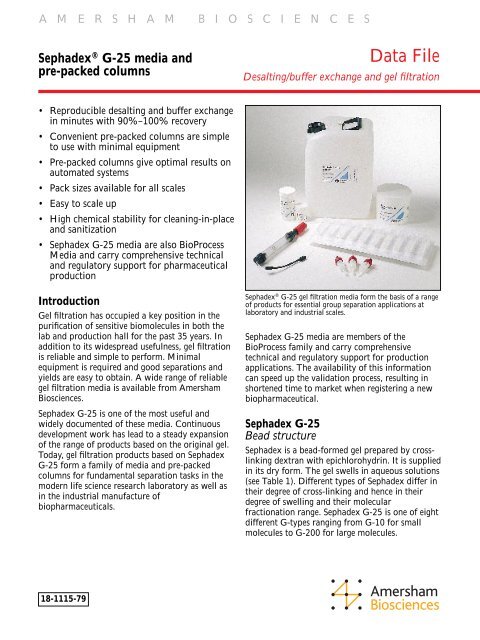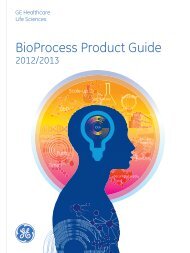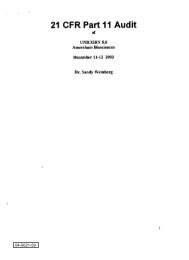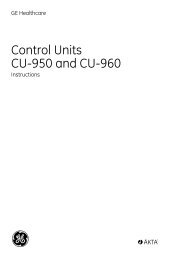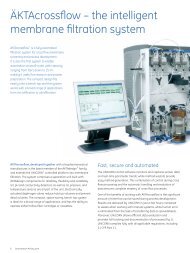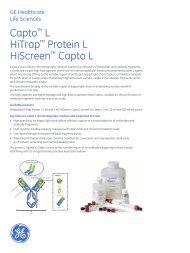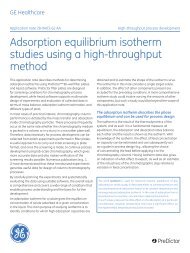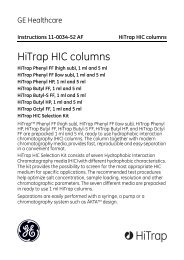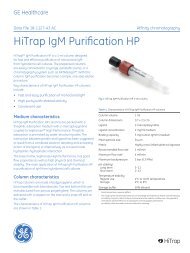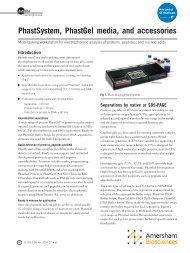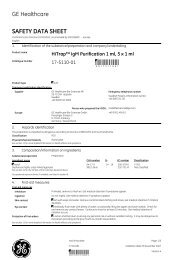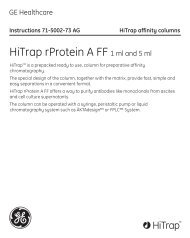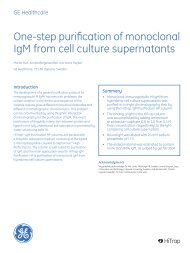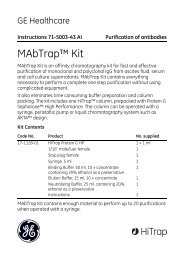Sephadex G-25 media and pre-packed columns - GE Healthcare ...
Sephadex G-25 media and pre-packed columns - GE Healthcare ...
Sephadex G-25 media and pre-packed columns - GE Healthcare ...
You also want an ePaper? Increase the reach of your titles
YUMPU automatically turns print PDFs into web optimized ePapers that Google loves.
A M E R S H A M B I O S C I E N C E S<br />
<strong>Sephadex</strong> ® G-<strong>25</strong> <strong>media</strong> <strong>and</strong><br />
<strong>pre</strong>-<strong>packed</strong> <strong>columns</strong><br />
• Reproducible desalting <strong>and</strong> buffer exchange<br />
in minutes with 90%–100% recovery<br />
• Convenient <strong>pre</strong>-<strong>packed</strong> <strong>columns</strong> are simple<br />
to use with minimal equipment<br />
• Pre-<strong>packed</strong> <strong>columns</strong> give optimal results on<br />
automated systems<br />
• Pack sizes available for all scales<br />
• Easy to scale up<br />
• High chemical stability for cleaning-in-place<br />
<strong>and</strong> sanitization<br />
• <strong>Sephadex</strong> G-<strong>25</strong> <strong>media</strong> are also BioProcess<br />
Media <strong>and</strong> carry com<strong>pre</strong>hensive technical<br />
<strong>and</strong> regulatory support for pharmaceutical<br />
production<br />
Introduction<br />
Gel filtration has occupied a key position in the<br />
purification of sensitive biomolecules in both the<br />
lab <strong>and</strong> production hall for the past 35 years. In<br />
addition to its wides<strong>pre</strong>ad usefulness, gel filtration<br />
is reliable <strong>and</strong> simple to perform. Minimal<br />
equipment is required <strong>and</strong> good separations <strong>and</strong><br />
yields are easy to obtain. A wide range of reliable<br />
gel filtration <strong>media</strong> is available from Amersham<br />
Biosciences.<br />
<strong>Sephadex</strong> G-<strong>25</strong> is one of the most useful <strong>and</strong><br />
widely documented of these <strong>media</strong>. Continuous<br />
development work has lead to a steady expansion<br />
of the range of products based on the original gel.<br />
Today, gel filtration products based on <strong>Sephadex</strong><br />
G-<strong>25</strong> form a family of <strong>media</strong> <strong>and</strong> <strong>pre</strong>-<strong>packed</strong><br />
<strong>columns</strong> for fundamental separation tasks in the<br />
modern life science research laboratory as well as<br />
in the industrial manufacture of<br />
biopharmaceuticals.<br />
18-1115-79<br />
<strong>Sephadex</strong> G-<strong>25</strong> <strong>media</strong> are members of the<br />
BioProcess family <strong>and</strong> carry com<strong>pre</strong>hensive<br />
technical <strong>and</strong> regulatory support for production<br />
applications. The availability of this information<br />
can speed up the validation process, resulting in<br />
shortened time to market when registering a new<br />
biopharmaceutical.<br />
<strong>Sephadex</strong> G-<strong>25</strong><br />
Bead structure<br />
Data File<br />
Desalting/buffer exchange <strong>and</strong> gel filtration<br />
<strong>Sephadex</strong> ® G-<strong>25</strong> gel filtration <strong>media</strong> form the basis of a range<br />
of products for essential group separation applications at<br />
laboratory <strong>and</strong> industrial scales.<br />
<strong>Sephadex</strong> is a bead-formed gel <strong>pre</strong>pared by crosslinking<br />
dextran with epichlorohydrin. It is supplied<br />
in its dry form. The gel swells in aqueous solutions<br />
(see Table 1). Different types of <strong>Sephadex</strong> differ in<br />
their degree of cross-linking <strong>and</strong> hence in their<br />
degree of swelling <strong>and</strong> their molecular<br />
fractionation range. <strong>Sephadex</strong> G-<strong>25</strong> is one of eight<br />
different G-types ranging from G-10 for small<br />
molecules to G-200 for large molecules.
Table 1. Dry <strong>and</strong> hydrated bead sizes of <strong>Sephadex</strong> G-<strong>25</strong>.<br />
In addition, <strong>Sephadex</strong> G-<strong>25</strong> is available in four<br />
different particle size grades (Coarse, Medium, Fine<br />
<strong>and</strong> Superfine). These four grades form the basis of<br />
a range of gel filtration products, discussed below.<br />
Separation principle<br />
Gel filtration separates molecules according to their<br />
relative sizes. In <strong>Sephadex</strong>, the degree of crosslinking<br />
of the dextran determines the extent to<br />
which macromolecules can permeate the beads.<br />
Large molecules are totally excluded while smaller<br />
sized molecules enter the beads to varying extents<br />
according to their different sizes. Large molecules<br />
thus leave the column first followed by smaller<br />
molecules in the order of their decreasing size.<br />
<strong>Sephadex</strong> G-<strong>25</strong> has a fractionation range for<br />
globular proteins of 1000–5000 molecular weight.<br />
The principles of gel filtration <strong>and</strong> the structures<br />
of <strong>Sephadex</strong> <strong>and</strong> other gel filtration <strong>media</strong> are<br />
explained in more detail in the h<strong>and</strong>book “Gel<br />
filtration – Principles <strong>and</strong> Methods”, which is<br />
available from Amersham Biosciences.<br />
Uses of gel filtration<br />
There are two distinct ways of applying gel<br />
filtration in a separation scheme.<br />
“Group separation” separates the components of a<br />
sample into two groups, e.g. high molecular weight<br />
substances, which are excluded from the gel <strong>and</strong><br />
thus elute first, from lower molecular weight<br />
substances that enter the pores <strong>and</strong> thus elute later.<br />
“Fractionation”, on the other h<strong>and</strong>, separates<br />
molecules of different sizes <strong>and</strong> can thus be used to<br />
fractionate complex samples into individual<br />
components.<br />
2<br />
Dry bead Hydrated <strong>media</strong>n Diameter ratio<br />
Product size µm diameter µm* hydrated/dry<br />
<strong>Sephadex</strong> G-<strong>25</strong> Coarse 100–300 320 1.62<br />
<strong>Sephadex</strong> G-<strong>25</strong> Medium 50–150 140 1.61<br />
<strong>Sephadex</strong> G-<strong>25</strong> Fine 20–80 88 1.56<br />
<strong>Sephadex</strong> G-<strong>25</strong> Superfine 20–50 52 1.57<br />
* Average values from three product batches of each grade.<br />
The separation range of <strong>Sephadex</strong> G-<strong>25</strong> makes it<br />
suitable for group separation work such as the<br />
removal of low molecular weight contaminants<br />
from molecules larger than about 5000 molecular<br />
weight.<br />
The effect of particle size<br />
Coarse <strong>and</strong> Medium grades are <strong>pre</strong>ferred for group<br />
separations at process scale where high flow rates<br />
<strong>and</strong> low operating <strong>pre</strong>ssures are required. The Fine<br />
<strong>and</strong> Superfine grades are for routine laboratory<br />
work including <strong>pre</strong>parative separations. The finer<br />
beads of the Fine <strong>and</strong> Superfine grades give shorter<br />
diffusion distances. This gives high efficiencies at<br />
high flow rates.<br />
Examples shown later illustrate several of these<br />
applications.<br />
The particle size of <strong>Sephadex</strong> is usually reported as<br />
dry diameter in µm (see Table 1). However, as the<br />
<strong>media</strong> are swollen before use, it is the wet bead<br />
diameter that is of practical importance when<br />
choosing the correct type of equipment to use.<br />
Table 1 therefore gives the hydrated <strong>media</strong>n<br />
diameter of the four grades of <strong>Sephadex</strong> G-<strong>25</strong><br />
swollen in 0.15 M sodium chloride. The diameter<br />
ratio hydrated/dry is also given.<br />
Note that the degree of swelling in organic solvents<br />
is not the same as in aqueous solutions, <strong>and</strong> must<br />
be determined by experiment for each solvent<br />
system. For routine use in organic solvents,<br />
lipophilic <strong>Sephadex</strong> LH-20 or <strong>Sephadex</strong> LH-60 is<br />
recommended.
Stability<br />
The mechanical strength <strong>and</strong> pH stability of<br />
<strong>Sephadex</strong> gel filtration <strong>media</strong> depend on the degree<br />
of cross-linking.<br />
<strong>Sephadex</strong> G-<strong>25</strong> is one of the more rigid of the<br />
family <strong>and</strong> has a working pH range of 2–13*. In<br />
trials, <strong>Sephadex</strong> G-<strong>25</strong> has been exposed to 0.1 M<br />
HCl for 1–2 hours <strong>and</strong> 0.02 M HCl for 6 months<br />
without affecting its chromatographic properties.<br />
Leakage studies have also shown that <strong>Sephadex</strong><br />
G-<strong>25</strong> withst<strong>and</strong>s long term exposure to NaOH.<br />
It may be safely stored in 0.01 M NaOH without<br />
affecting its performance. 20% ethanol may also be<br />
used for storage. For cleaning-in-place <strong>and</strong><br />
sanitization, 60–90 minutes exposure to 0.2 M<br />
NaOH followed by flushing with water or buffer is<br />
recommended. This procedure can be used for<br />
hundreds of cleaning cycles.<br />
<strong>Sephadex</strong> <strong>media</strong> can be autoclaved in their wet<br />
form (pH 7.0) at 120 °C for 30 minutes.<br />
The rigidity of the matrix means that <strong>Sephadex</strong><br />
G-<strong>25</strong> can be used at relatively high flow rates for<br />
rapid separations. Please refer to the applications<br />
section for details.<br />
Batch-to-batch reproducibility<br />
Consistent quality <strong>and</strong> performance from batch-tobatch<br />
is important for all separation <strong>media</strong>, but it<br />
assumes extra significance when the <strong>media</strong> are<br />
routinely used in industrial processes. Quality<br />
control data gathered from nearly 200 production<br />
batches of <strong>Sephadex</strong> G-<strong>25</strong> Coarse grade show<br />
outst<strong>and</strong>ing batch-to-batch consistency for more<br />
than 30 years (Table 2).<br />
* Working pH is the pH at which the medium can be used routinely<br />
without adverse effects to the matrix.<br />
Working with <strong>Sephadex</strong> G-<strong>25</strong><br />
Column dimensions<br />
In gel filtration, column length is important for<br />
resolution <strong>and</strong> column diameter determines loading<br />
capacity. In fractionation work, long <strong>columns</strong><br />
(30–100 cm) <strong>and</strong> small sample volumes give the<br />
best resolution. For group separations, however,<br />
short (5–30 cm), wide <strong>columns</strong> give excellent<br />
results at high sample loadings.<br />
Column packing<br />
As <strong>Sephadex</strong> is supplied as a dry powder, it must be<br />
swollen in buffer before packing in the column.<br />
Laboratory <strong>columns</strong> are simply <strong>packed</strong> by pouring<br />
the swollen G-<strong>25</strong> slurry into the column <strong>and</strong> using<br />
a pump to pack the gel bed at as high a flow rate as<br />
possible without deforming the beads. The result is<br />
an evenly <strong>packed</strong> stable gel with consistently good<br />
separation performance.<br />
Packing process scale <strong>columns</strong> requires modified<br />
techniques but nevertheless gives excellent results<br />
<strong>and</strong> consistent performance. Well-proven methods<br />
for a range of large scale column types both with<br />
<strong>and</strong> without adjustable adaptors are readily<br />
available upon request.<br />
Cleaning a <strong>packed</strong> column<br />
When a column has been in use for some time, it<br />
may be necessary to remove <strong>pre</strong>cipitated proteins<br />
or other contaminants that have built up on the gel<br />
bed. Columns <strong>packed</strong> with <strong>Sephadex</strong> G-<strong>25</strong> may be<br />
cleaned with 2 column volumes of 0.2 M NaOH or<br />
a non-ionic detergent solution (60–90 minutes<br />
exposure). The frequency of cleaning will depend<br />
on the nature of the sample material <strong>and</strong> should be<br />
worked out on a case-by-case basis.<br />
Table 2. Quality control data demonstrate the outst<strong>and</strong>ing batch-to-batch consistency of <strong>Sephadex</strong> G-<strong>25</strong> Coarse over thirty<br />
years.<br />
Year of Water regain Particle size distr. Non-specific adsorption –<br />
Batch no. production ml/g Vol. % 100–300 µm % recovery of cytochrome C<br />
(Limits) – (2.3–2.7) (min. 90) (min. 85)<br />
1 1963 2.52 – –<br />
40 1970 2.50 96 88<br />
80 1974 2.43 99.8 93<br />
115 1979 2.53 94.0 92<br />
150 1985 2.50 96.3 90<br />
175 1989 2.48 96.0 94<br />
180 1994 2.43 96.1 96<br />
3
Scale-up<br />
Scaling up a separation based on <strong>Sephadex</strong> G-<strong>25</strong> to<br />
pilot level <strong>and</strong> then into routine production is<br />
straightforward <strong>and</strong> trouble-free. Well known<br />
examples of successful commercial applications<br />
include buffer exchange in processes for removing<br />
endotoxins from albumin (see applications section)<br />
<strong>and</strong> as a <strong>pre</strong>parative step during the production of<br />
vaccines.<br />
Gel filtration products based on<br />
<strong>Sephadex</strong> G-<strong>25</strong><br />
Laboratory <strong>and</strong> process scale <strong>media</strong><br />
packs<br />
These are the most flexible <strong>and</strong> economical way to<br />
use <strong>Sephadex</strong> G-<strong>25</strong> on a regular basis. Each of the<br />
four grades is available in a range of pack sizes (see<br />
Ordering information).<br />
Mini-packs<br />
<strong>Sephadex</strong> G-<strong>25</strong> Medium grade is available in a<br />
Mini-pack size of <strong>25</strong> g. Mini-packs offer users a<br />
quick <strong>and</strong> affordable opportunity to try this grade<br />
of <strong>Sephadex</strong> G-<strong>25</strong> in their applications.<br />
Step-by-step instructions for optimal packing <strong>and</strong><br />
running are included in each pack.<br />
Pre-<strong>packed</strong> <strong>columns</strong><br />
Table 3 lists four column types <strong>pre</strong>-<strong>packed</strong> with<br />
<strong>Sephadex</strong> G-<strong>25</strong> <strong>media</strong> <strong>and</strong> gives some basic column<br />
properties. Their fundamental characteristics are<br />
summarized below.<br />
Pre-<strong>packed</strong> Disposable Columns PD-10<br />
PD-10 <strong>columns</strong> are available in boxes of 30<br />
<strong>columns</strong>, each containing 8.5 ml <strong>Sephadex</strong> G-<strong>25</strong><br />
Medium. They can desalt sample volumes of up to<br />
2.5 ml with high recovery <strong>and</strong> low dilution. In use,<br />
the column is suspended over a test tube <strong>and</strong><br />
equilibrated with buffer. The sample is then applied<br />
Table 3. Pre-<strong>packed</strong> <strong>columns</strong> containing <strong>Sephadex</strong> G-<strong>25</strong>.<br />
4<br />
<strong>and</strong> the high molecular weight fraction is eluted in<br />
the void volume by gravity flow. The separation<br />
takes about 5 minutes. PD-10 <strong>columns</strong> are<br />
inexpensive <strong>and</strong> can be disposed of after use to<br />
eliminate sample cross-contamination.<br />
HiTrap Desalting<br />
HiTrap ® Desalting is a medical grade plastic<br />
column <strong>pre</strong>-<strong>packed</strong> with 5 ml <strong>Sephadex</strong> G-<strong>25</strong><br />
Superfine. Its low back-<strong>pre</strong>ssure enables fast<br />
separations using either a syringe, a peristaltic<br />
pump or a liquid chromatography system.<br />
Recommended flow rates are high (up to<br />
10 ml/min) with a maximum of 15 ml/min, <strong>and</strong><br />
with separation times of about 1–2 minutes. The<br />
recommended sample volume for each column is<br />
up to 1.5 ml <strong>and</strong> can be scaled up to 7.5 ml by<br />
connecting up to five <strong>columns</strong> in series.<br />
Fast Desalting HR 10/10<br />
Fast Desalting HR 10/10 is high performance<br />
column specially designed for fast <strong>and</strong> convenient<br />
group separations on FPLC ® System. It comprises a<br />
high resolution HR 10/10 glass column <strong>pre</strong>-<strong>packed</strong><br />
with 8 ml <strong>Sephadex</strong> G-<strong>25</strong> Superfine. Fast Desalting<br />
HR 10/10 can be used at flow rates up to 6 ml/min,<br />
giving a separation time of 1–2 minutes <strong>and</strong> is an<br />
ideal column for rapid, routine group separations<br />
in automated systems.<br />
Fast Desalting PC 3.2/10<br />
Fast Desalting PC 3.2/10 is optimised for use on<br />
the micro<strong>pre</strong>parative scale with SMART ®<br />
chromatography system. It is <strong>packed</strong> with<br />
<strong>Sephadex</strong> G-<strong>25</strong> Superfine, but the narrow column<br />
diameter gives a much smaller bed volume (0.8 ml)<br />
which is ideal for smaller samples. The column is<br />
made of glass <strong>and</strong> fluoroplastics with a titanium<br />
filter. The maximum recommended flow rate is<br />
0.9 ml/min <strong>and</strong> the operational <strong>pre</strong>ssure limit is<br />
1.2 bar. Typical separation times are 1–2 minutes.<br />
Fast Desalting PC 3.2/10 is also ideal for routine<br />
use in automated separation schemes, especially<br />
when recovery of limited samples is critical.<br />
Pre-<strong>packed</strong> column G-<strong>25</strong> grade Bed vol. Rec. flow rate range Equipment Max. sample vol.<br />
PD-10 Medium 8.5 ml gravity flow st<strong>and</strong> alone 2.5 ml<br />
HiTrap Desalting Superfine 5 ml 1–10 ml/min syringe/pump 1.5 ml<br />
Fast Desalting HR 10/10 Superfine 8 ml 2–6 ml/min st<strong>and</strong>ard LC equipment 2.4 ml<br />
Fast Desalting PC 3.2/10 Superfine 0.80 ml 0.01–0.9 ml/min SMART System or HPLC 0.2 ml
The new Column Holder 10 cm now allows this<br />
column to be run on high performance liquid<br />
chromatography systems (HPLC), including<br />
microbore HPLC.<br />
Applications of <strong>Sephadex</strong> G-<strong>25</strong> <strong>media</strong><br />
<strong>and</strong> <strong>pre</strong>-<strong>packed</strong> <strong>columns</strong><br />
As noted earlier, group separation of biomolecules<br />
is the most widely used application of <strong>Sephadex</strong><br />
G-<strong>25</strong>. With a fractionation range for globular<br />
proteins of 1000–5000 molecular weight, this<br />
ensures group separations of proteins/peptides<br />
larger than 5000 from molecules with a molecular<br />
weight less than 1000.<br />
Buffer exchange <strong>and</strong> desalting are common<br />
examples of group separations. Buffer exchange is<br />
frequently necessary when the buffer composition<br />
of the sample must be changed between<br />
chromatography steps. Desalting a sample is often<br />
needed before ion exchange <strong>and</strong> after hydrophobic<br />
interaction or affinity chromatography.<br />
At small scale, gel filtration with <strong>Sephadex</strong> G-<strong>25</strong><br />
has replaced much slower <strong>and</strong> more cumbersome<br />
dialysis. Simple-to-use <strong>pre</strong>-<strong>packed</strong> <strong>columns</strong> such as<br />
the PD-10 <strong>and</strong> HiTrap Desalting are now popular<br />
tools for desalting or buffer exchange. Figure 1<br />
shows the removal of NaCl from albumin on a<br />
PD-10 column (<strong>Sephadex</strong> G-<strong>25</strong> Medium).<br />
Concentration<br />
Albumin NaCl<br />
0 2 4 6 8 10 12<br />
Elution volume (ml)<br />
Fig. 1. Removal of NaCl from albumin solution. A PD-10<br />
column containing <strong>Sephadex</strong> G-<strong>25</strong> Medium was equilibrated<br />
with distilled water. The sample contained human serum<br />
albumin (<strong>25</strong> mg) dissolved in NaCl solution (0.5 M, 2.5 ml).<br />
Yield of albumin in 3.5 ml after sample application (between<br />
arrows) was 95.3%. The salt content was 2.0% of that<br />
originally <strong>pre</strong>sent.<br />
Figure 2 illustrates the scalability of <strong>Sephadex</strong> G-<strong>25</strong><br />
for a similar application. Here a production scale<br />
75 liter stainless steel column was used for the<br />
buffer exchange step in the the production of<br />
albumin <strong>and</strong> IgG from human plasma.<br />
Column: BPSS 400/600, 75 litres<br />
Sample: 10 litres human plasma<br />
1: Sample application<br />
2: Eluent<br />
Eluent: 0.0<strong>25</strong> M sodium acetate<br />
Flow rate: 240 L/h<br />
OD280 Conductivity<br />
1 2 1 2 1 2 1 2 1 2<br />
Elution volume<br />
Fig. 2. Chromatogram of the buffer exchange step on<br />
<strong>Sephadex</strong> G-<strong>25</strong> Coarse during the production of albumin <strong>and</strong><br />
IgG from human plasma.<br />
Figure 3 shows process data from a buffer<br />
exchange step on <strong>Sephadex</strong> G-<strong>25</strong> Coarse included<br />
in a process for removal of endotoxins <strong>and</strong>/or<br />
ethanol from albumin. The high throughput of<br />
<strong>Sephadex</strong> G-<strong>25</strong> Coarse grade resulted in a rapid<br />
<strong>and</strong> efficient separation despite the high<br />
concentration of protein in the feedstock.<br />
Various<br />
source<br />
material<br />
from Cohn<br />
fractionation<br />
5% solution<br />
containing stabilizers<br />
400 L<br />
Volume of feedstock<br />
applied per cycle: 12 L<br />
No. of cycles:<br />
Process time, h: 33<br />
7.4<br />
20% solution<br />
containing stabilizers<br />
100 L<br />
Dilution with water to 200 L<br />
Albumin conc. 10%<br />
400 L 200 L <strong>25</strong>0 L<br />
Step 1<br />
<strong>Sephadex</strong> G-<strong>25</strong> Coarse<br />
BPSS 400/600 column<br />
Column volume: 75 L<br />
17<br />
3.9<br />
21<br />
4.7<br />
800 L 400 L 500 L<br />
Process continued<br />
Fraction V paste<br />
140 kg<br />
Suspension with <strong>25</strong>0 L of water<br />
Albumin conc. 8-10%<br />
Ethanol conc. 10%<br />
Filtration through<br />
Filtrox K10, Seitz K 10,<br />
Cuno 60 or equivalent<br />
Surface area 1.8 m 2<br />
Eluent: water for injection<br />
Linear flow rate: 240 cm/h<br />
Flow rate: 5 L/min<br />
Cycle time: 17.4 min<br />
Cleaning: 26 L, 0.5 M NaOH<br />
Storage: 105 L, 0.01 M NaOH<br />
Equilibration: 375 L<br />
Max total water consumption: 3000 L<br />
Column dimensions:<br />
diameter: 40 cm<br />
height: 60 cm<br />
Fig. 3. Process data of a buffer exchange step on <strong>Sephadex</strong><br />
G-<strong>25</strong> Coarse from a production scale process to remove<br />
endotoxins <strong>and</strong>/or ethanol from albumin.<br />
5
HiTrap Desalting <strong>columns</strong> can easily be attached to<br />
other <strong>columns</strong> for on-line buffer exchange as<br />
shown in Fig. 4b. The pH of mouse monoclonal<br />
IgG eluted from a HiTrap Protein G affinity<br />
column was adjusted by connecting a HiTrap<br />
Desalting column in series. Figure 4a shows the<br />
original separation without the extra desalting step.<br />
The yield obtained was 18% higher when the<br />
HiTrap Desalting column was used for on-line<br />
desalting (Fig. 4b).<br />
6<br />
Column: HiTrap Protein G, 1 ml <strong>and</strong> HiTrap Desalting<br />
Sample: Eluted mouse monoclonal IgG from the HiTrap Protein G<br />
column<br />
Eluents: HiTrap Protein G. Binding: 20 mM sodium phosphate pH 7.0.<br />
Elution: 0.1 M glycine pH 2.7<br />
Flow rate: 2 ml/min<br />
Detection: UV: 0–2.0 AUFS, 5 mm cell, 280 nm<br />
pH: measured on 0.5 ml fractions<br />
1.5<br />
1.0<br />
0.5<br />
AU 280nm<br />
Wash<br />
Mouse IgG<br />
Elution<br />
0.0<br />
2.0<br />
0.0 5.0 10.0 15.0 20.0 Vol. (ml)<br />
1.5<br />
1.0<br />
0.5<br />
AU 280nm<br />
Wash<br />
A<br />
B<br />
Elution<br />
Mouse IgG<br />
HiTrap Desalting<br />
connected<br />
0.0<br />
2.0<br />
0.0 5.0 10.0 15.0 20.0 Vol. (ml)<br />
Fig. 4. On-line buffer exchange with HiTrap Desalting<br />
(<strong>Sephadex</strong> G-<strong>25</strong> Superfine) improves the yield from a HiTrap<br />
Protein G affinity purification.<br />
A further group separation that illustrates the<br />
usefulness of HiTrap Desalting is shown in Fig. 5.<br />
During coupling of IgG to NHS-activated<br />
Sepharose (HiTrap NHS-activated) N-Hydroxy<br />
Succinimide (NHS) is released. NHS shows strong<br />
absorbance at 280 nm. To measure the coupling<br />
yield NHS must be removed. In this example, the<br />
column was operated using a syringe.<br />
pH<br />
pH<br />
8.0<br />
6.0<br />
4.0<br />
8.0<br />
6.0<br />
4.0<br />
Column: HiTrap Desalting<br />
Sample Unbound human IgG in 0.2 M sodium carbonate buffer<br />
pH 8.5 after coupling to a HiTrap NHS 1 ml column<br />
Sample volume: 0.5 ml<br />
Eluent: 0.2 M sodium carbonate buffer pH 8.5<br />
Fraction volume: 0.5 ml<br />
System: Syringe<br />
A280<br />
2.0<br />
1.5<br />
1.0<br />
0.5<br />
0.0<br />
Finally, Figure 6 shows a high resolution group<br />
separation. Here free 1<strong>25</strong> I was removed from<br />
labelled insulin on a Fast Desalting HR 10/10<br />
column run on FPLC System.<br />
A 280nm<br />
H-IgG<br />
Insulin<br />
MW 5740<br />
Chloramine T<br />
N-Hydroxysuccinimide<br />
0 2 4 6 8 10 12 14 16 18 20<br />
Fraction no.<br />
Fig 5. HiTrap Desalting operated with a syringe to remove<br />
unwanted components following a coupling reaction.<br />
Column: Fast Desalting HR 10/10<br />
Sample: 0.4 mg/ml insulin – 1<strong>25</strong> I, 1<strong>25</strong> I, Chloramine T, 200 µl<br />
Buffer: 50 mM Na-phosphate pH 7.4, 0.05% Tween 20<br />
Flow rate: 4 ml/min<br />
Radioactivity<br />
A 280nm<br />
1<strong>25</strong><br />
I<br />
0 4 Time (min)<br />
Fig. 6. Removal of free 1<strong>25</strong> I from labelled insulin on a Fast<br />
Desalting HR 10/10 column (<strong>Sephadex</strong> G-<strong>25</strong> Superfine) run on<br />
FPLC System.
Ordering information<br />
Product Quantity Code No.<br />
<strong>Sephadex</strong> G-<strong>25</strong> Coarse 100 g 17-0034-01<br />
<strong>Sephadex</strong> G-<strong>25</strong> Coarse 500 g 17-0034-02<br />
<strong>Sephadex</strong> G-<strong>25</strong> Coarse 5 kg 17-0034-03<br />
<strong>Sephadex</strong> G-<strong>25</strong> Coarse 40 kg 17-0034-07<br />
<strong>Sephadex</strong> G-<strong>25</strong> Medium <strong>25</strong> g* 17-0033-10<br />
<strong>Sephadex</strong> G-<strong>25</strong> Medium 100 g 17-0033-01<br />
<strong>Sephadex</strong> G-<strong>25</strong> Medium 500 g 17-0033-02<br />
<strong>Sephadex</strong> G-<strong>25</strong> Medium 5 kg 17-0033-03<br />
<strong>Sephadex</strong> G-<strong>25</strong> Medium 40 kg 17-0033-07<br />
<strong>Sephadex</strong> G-<strong>25</strong> Fine 100 g 17-0032-01<br />
<strong>Sephadex</strong> G-<strong>25</strong> Fine 500 g 17-0032-02<br />
<strong>Sephadex</strong> G-<strong>25</strong> Fine 5 kg 17-0032-03<br />
<strong>Sephadex</strong> G-<strong>25</strong> Fine 40 kg 17-0032-07<br />
<strong>Sephadex</strong> G-<strong>25</strong> Superfine 100 g 17-0031-01<br />
<strong>Sephadex</strong> G-<strong>25</strong> Superfine 500 g 17-0031-02<br />
<strong>Sephadex</strong> G-<strong>25</strong> Superfine 5 kg 17-0031-03<br />
* Mini-pack size.<br />
Pre-<strong>packed</strong> <strong>columns</strong><br />
Pre-<strong>packed</strong> column Quantity Code No.<br />
Pre-<strong>packed</strong> Disposable<br />
Columns PD-10 30 17-0851-01<br />
HiTrap Desalting (includes<br />
Luer adaptors, tubing<br />
connectors <strong>and</strong> domed nuts) 5 × 5 ml 17-1408-01<br />
Fast Desalting Column<br />
HR 10/10 1 17-0591-01<br />
Fast Desalting PC 3.2/10 1 17-0774-01<br />
Large scale <strong>columns</strong><br />
Amersham Biosciences has a large range of <strong>columns</strong> for<br />
scale up <strong>and</strong> commercial production. Contact your<br />
local re<strong>pre</strong>sentative for more information.<br />
Further information<br />
More details of the gel filtration technique can be<br />
found in the Amersham Biosciences h<strong>and</strong>book “Gel<br />
filtration – Principles <strong>and</strong> Methods” code no.<br />
18-1022-18. Further product <strong>and</strong> application<br />
information is available in the Amersham Biosciences<br />
general <strong>and</strong> process scale catalogues. Contact your<br />
local office for your own copies.<br />
7
Printed in Sweden by Wikströms, Uppsala 96.04 960247


